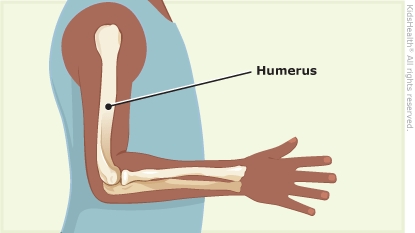The humerus (HYOO-mer-us) is the bone in the upper arm between the shoulder and the elbow. Your child has a fracture (crack or break) in the humerus.
At first, health care providers usually treat a broken humerus with an immobilizer. An immobilizer is a device (such as a sling or a brace) that keeps the arm and shoulder very still so the broken bone can heal. Sometimes other treatments, like a cast or a splint, are needed too. Once the broken humerus starts to heal, your health care provider will want your child to do certain exercises to make sure their elbow and shoulder don't get stiff. Here's how to care for your child at home.

Follow your health care provider's recommendations for:
- Using and caring for the immobilizer.
- Whether your child can take the immobilizer off, for example, for bathing or doing exercises. (Do not allow your child to take the immobilizer off unless your health care provider says it's OK.)
- How to bathe with the immobilizer.
- How to care for a cast or splint (if your child has one).
- What activities to avoid (such as sports, gym class, and playground equipment).
- Whether it's OK for your child to drive.
- Any exercises or stretches your child should do. (Pay close attention to when your child should start these exercises, since the health care provider will want your child to keep the arm still at first.)
- Going to an orthopedic specialist (a health care provider who specializes in bone care) or a physical therapist.
- When to follow up.
For pain and swelling:
- Give any medications as recommended by your health care provider. These may include prescription pain medicine, acetaminophen (Tylenol® or a store brand), or ibuprofen (Advil®, Motrin®, or a store brand). Some prescription pain medicines also include acetaminophen or ibuprofen. To avoid giving too much, give the medicines exactly as your health care provider recommends. Don't give ibuprofen to babies under 6 months old.
- Help your child get their mind off the pain by:
- Doing something they enjoy, such as reading a book or watching a show together
- Playing relaxing music
- Put ice in a plastic bag wrapped in a towel on the outside of the immobilizer for 20 minutes, every 3 hours. Don't put ice directly on the immobilizer.
- Some kids are more comfortable sleeping sitting up in a soft chair or a recliner for the first week.
- Remind your child to wiggle their fingers to keep blood flowing normally. Check the fingertips each day to make sure they are pink and not pale, swollen, or numb.

How long will my child need the immobilizer? Most kids need to wear the immobilizer for 6‒8 weeks.
When can my child return to sports? Most kids can return to gym class and sports after a few months, but this can vary. The health care provider will tell you when it's OK for your child to return to sports.




